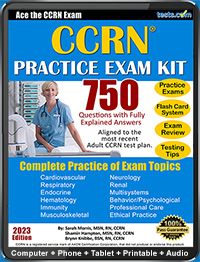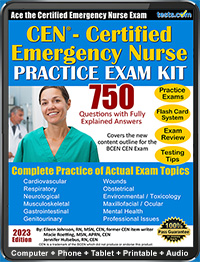1.
A 47-year-old male has been admitted to the CCU from the emergency room with a history of sudden diaphoresis, nausea, vomiting and radiating pain down his left arm. He reports no significant medical history, and has been a two PPD smoker since his early twenties. His admitting diagnosis is UA/NSTEMI and he is being prepped for cardiac catheterization for possible angioplasty with stent placement. What type of medication orders might the nurse see prior to his procedure?
a. Clopidogrel and ASA
b. Clopidogrel and prasugrel
c. Clopidogrel and meperidine
d. Prasugrel, ASA, and hyoscyamine
In 2011, a joint task force of the American College of Cardiology Foundation and the American Heart Association published updated guidelines for the treatment of unstable angina (UA) with non-ST elevation myocardial infarction (NSTEMI). These guidelines recommend that all patients with this diagnosis receive ASA on admission, and throughout hospitalization, if tolerated. If a patient is scheduled for percutaneous coronary intervention (PCI), it is recommended that a second anti-platelet therapy be added, such as clopidogrel (Plavix).
Incorrect answer. Please choose another answer.
2.
Agnes is a 65-year-old white female who has a history of pulmonary fibrosis with steroid use for the past two years with concomitant hypertension. She has been on oxygen therapy at 4L per nasal cannula for the past 3 years. Recently, her first great-grandchild was born, and she decided to quit smoking. Three days ago, she experienced nausea and dizziness and was admitted to the CCU with a diagnosis of acute myocardial infarction. During shift change, Agnes' low blood pressure alarm sounds. Upon assessment, she is diaphoretic and has severe dyspnea. What is the most likely cause of her symptoms?
a. Exacerbation of pulmonary fibrosis
b. Pulmonary embolism
c. Recurrent myocardial infarction
d. Papillary muscle rupture
Myocardial rupture can be a catastrophic sequelae of acute myocardial infarction. It can occur in several sites in the heart after AMI, including the left papillary muscle. This event typically occurs 3-5 days after the AMI has occurred, and is more common in women who have a history of hypertension and are over the age of 60. The posteromedial papillary muscle is twice as likely to rupture as the anterolateral papillary muscle, due to the additional blood supply to the latter. Symptoms may include hypotension, shortness of breath, acute pulmonary edema and shock. Generally, mitral valve replacement is the most effective treatment.
Incorrect answer. Please choose another answer.
3.
Norman is a 65-year-old paraplegic who resides in a nursing home. He presents with a 3-day history of increased temperature, productive cough, and increased weakness. His caregiver states that he had developed a decubitis ulcer, and has not been able to tolerate sitting in his wheelchair, so has been in bed for the past week. Bibasilar crackles are audible on auscultation, with overall diminished breath sounds bilaterally. Obvious respiratory distress is apparent with tachypnea, suprasternal retractions and use of accessory muscles. Vitals: T-100.2F, HR-120, RR-28, BP 104/50, O2 Sat on RA - 88%. An initial chest x-ray reveals the "spine sign" and a normal cardiac silhouette. What is the most likely cause of Norman's condition?
a. CAP
b. HCAP
c. NHAP
d. HAP
The most likely cause for Norman's condition is nursing home-associated pneumonia (NHAP). NHAP is a subcategory of institutional-acquired pneumonia (IAP), which also includes healthcare associated pneumonia (HCAP). Patients in these settings are at increased risk for exposure to multi-drug resistant (MDR) bacteria. Debility and compromised health status increase the potential for infection.
Incorrect answer. Please choose another answer.
Study Online Instantly
Click to Save 50% Now
10.
Donna is a 43-year-old teacher who was admitted 6 days ago with a ruptured middle cerebral artery (MCA) aneurysm with subarachnoid hemorrhage (SAH). She underwent surgery for aneurysm clipping 12 hours after admission, and has had an excellent post-operative course. However, this morning, she complained of a severe headache, became acutely confused and quickly progressed to unresponsiveness. What is the likely cause for Donna's change of status?
a. Expansion of her original SAH
b. Uncal herniation
c. Cerebral vasospasm
d. Medication reaction
Donna is most likely experiencing vasospasm of one or more of her cerebral arteries. When this occurs, it is generally within 4-14 days for patients who have never had a cerebral bleed in the past, and sooner if this bleed is a recurrence. Usually, the site of spasm is unrelated to the site of rupture. Vasospasm is a serious complication, as it can lead to impaired cerebral autoregulation, cerebral ischemia, and infarction.
Incorrect answer. Please choose another answer.
15.
Andrew is a 47-year-old with advanced amyotrophic lateralizing sclerosis (ALS). He requires total assistance for positioning, bathing and mobility. His swallowing is impaired, so he takes nothing by mouth and receives nutrition through tube feedings via a gastrostomy tube. Based on his current condition, what type of asphyxia may Andrew be most susceptible to?
a. Cardiac asphyxia
b. Neurological asphyxia
c. Foreign body asphyxia
d. Positional asphyxia
Due to his weakness and inability to position himself, Andrew is susceptible to positional asphyxia. Positional asphyxia is associated with compromised respiratory function due to external factors which impair chest expansion, or create occlusion of the upper airway due to abnormal body position. Victims of positional asphyxia are unable to remove themselves from situations which compromise their respiratory status for various reasons, including cognitive and coordination impairment due to intoxication, sedation, neurological abnormalities, impaired consciousness, physical impairment or restraint.
Incorrect answer. Please choose another answer.
18.
Jerry is a 55-year-old veteran who has been admitted after a motor vehicle accident with multiple injuries. His friend reported that he had been using synthetic marijuana prior to the accident, and that he also sees a psychiatrist at the VA hospital for an unknown diagnosis. He stated that Jerry sometimes gets "hyper" for no reason, starts "ranting" and becomes violent. Of the following, which general psychiatric disorder is characterized by a pattern of aggression or violence which includes irritability, agitation, and violent behavior during manic or psychotic episodes?
a. Schizophrenia
b. Post-traumatic stress disorder (PTSD)
c. Bipolar disorder
d. Delusional disorder
The pattern of aggression or violence of bipolar disorder includes irritability, agitation, and violent behavior during manic or psychotic episodes, which is highly co-morbid with substance use, which worsens the prognosis. The Diagnostic and Statistical Manual of Mental Disorders identifies several disorders which may carry a higher risk for violent and/or aggressive behaviors, which is a concern when patients with co-morbid psychiatric disorders are admitted to the ICU or general floor for medical-surgical needs.
Incorrect answer. Please choose another answer.




